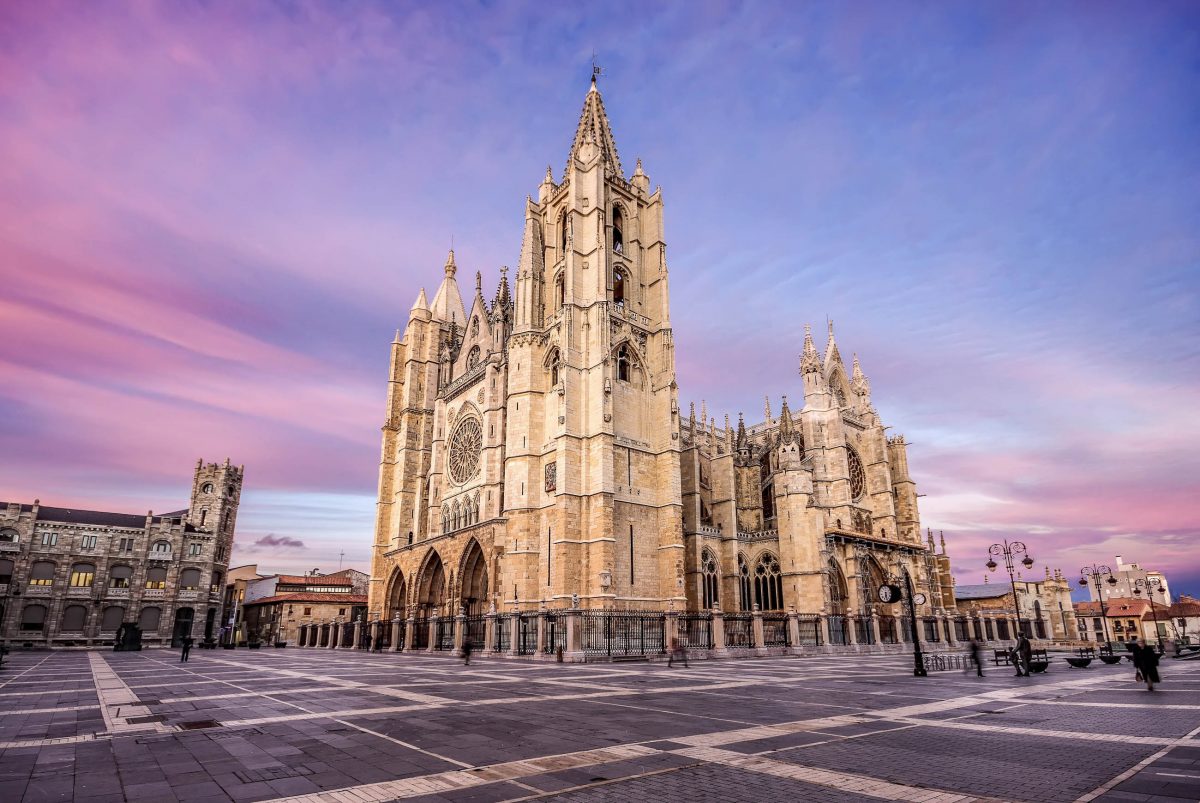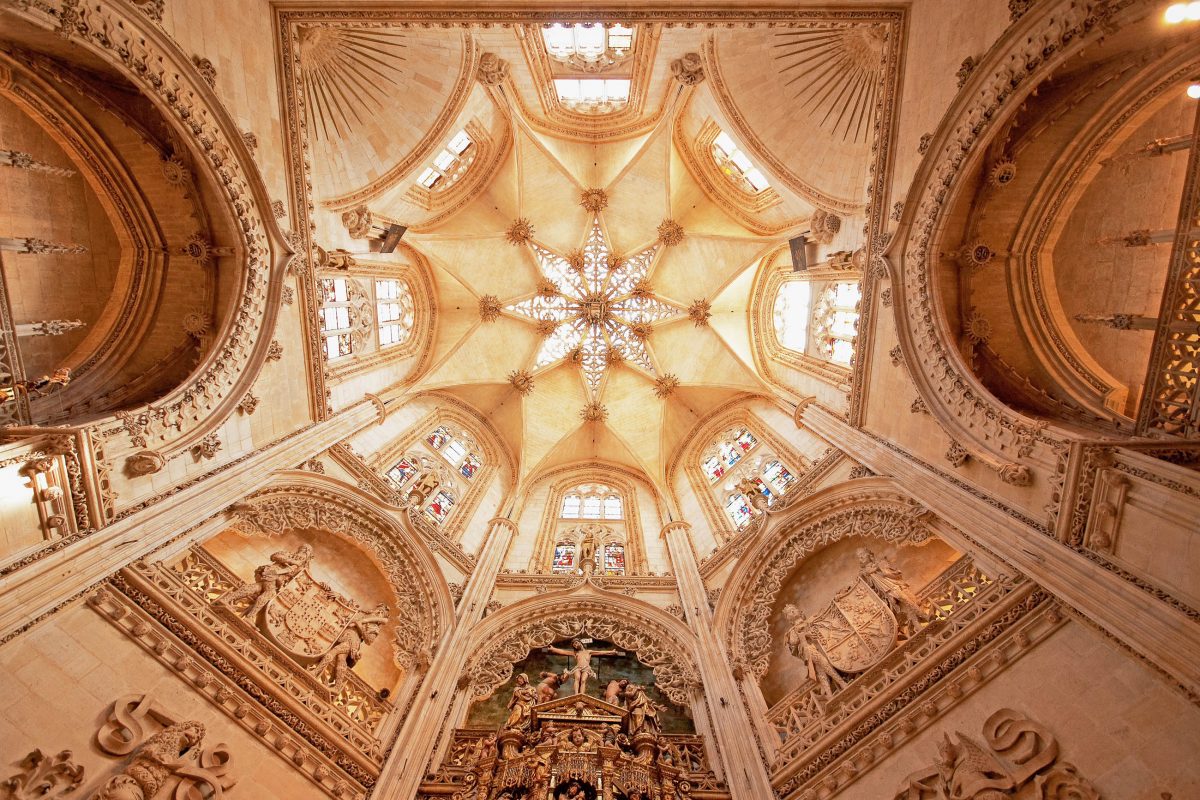Die Kathedrale in der spanischen Stadt Burgos ist eine wichtige Station auf dem Jakobsweg. Ihre atemberaubende Pracht sollte den damaligen Wohlstand der Handelsstadt symbolisieren.
Die Kathedrale von Burgos befindet sich in der Stadt Burgos im Norden Spaniens und ist die Bischofskirche des gleichnamigen Erzbistums. In der Region Castilly y León gelegen stellt sie eine wichtige Station auf dem Jakobsweg dar. Seit 1984 zählt sie zum Weltkulturerbe der UNESCO und auch wir haben sie auf unsere Liste der 10 schönsten Kirchen Spaniens gesetzt.
Inhaltsverzeichnis
BILDER: Kathedrale von Burgos
Fotogalerie: Kathedrale von Burgos
Geschichte der Kathedrale von Burgos

Die Kathedrale von Burgos entstand im 13. Jahrhundert aus einer älteren romanischen Kirche. Zu dieser Zeit war Burgos, die Hauptstadt von Kastilien, eine Diözese und wichtige Station der Pilger auf dem Jakobsweg. Außerdem verlief der Wollhandel nach Flandern und England über Burgos, was der Stadt großen Wohlstand bescherte. Die prachtvolle Kathedrale von Burgos sollte diesen Wohlstand symbolisieren.
Ihr Bau wurde unter König Ferdinand III. und Bischof Mauricio begonnen. Letzterer weihte den Altar nur neun Jahre nach dem ersten Spatenstich; danach standen die Arbeiten an der Kathedrale für etwa 200 Jahre still.
Erst 1435 wurde der Bau an dem imposanten Gotteshaus fortgesetzt. Auslöser dafür war die Rückkehr des damaligen Bischofs von Burgos, Alfons de Cartegna, vom Konzil in Basel. In seinem Geleit befand sich der deutsche Baumeister Johann von Köln, unter den Spaniern Juan de Colonia genannt, welcher später die Türme der Kathedrale vollendete.
Im 15. Jahrhundert wurden nachträglich mehrere Kapellen an die Kathedrale angebaut, und auch der Kreuzgang und der erzbischöfliche Palast entstanden zu dieser Zeit. Die Bauarbeiten an der Kathedrale endeten im 16. Jahrhundert; das Bauwerk ist heute der Jungfrau Maria geweiht.
Besuch der Kathedrale von Burgos

Neben dem Haupteingang, welcher durch das Vergebungs-Portal (Puerta del Perdón) gebildet und von den zwei mächtigen Türmen flankiert wird, gibt es noch drei weitere Eingänge ins Innere der Kathedrale, die allesamt meisterhafte Verzierungen aufweisen:
- das Coroneria-Portal in der nördlichen Querhauswand, welches eine Darstellung des Jüngsten Gerichts zeigt
- das Sarmental-Portal in der südlichen Querhauswand, an dem Christus mit den schreibenden Evangelisten dargestellt ist
- das Pellejería-Portal, der östliche Zugang zum nördlichen Querhaus, an dem das Bildnis der Mutter Gottes mit Engeln sowie das Martyrium Johannes des Täufers dargestellt sind
Imposante Architektur der Kathedrale von Burgos

Der imposante Sakralbau in Burgos besteht aus einem dreischiffigen Langhaus, einem Chor und einem einschiffigen Querhaus. Sie ist im Stil der französischen Gotik erbaut, zu erkennen unter anderem an der kunstvollen Figuren- oder Königsgalerie an der Westfassade.
Diese befindet sich in einer offenen Galerie unter der 50 Meter hohen Kuppel, welche von einer Statue der Jungfrau Maria gekrönt wird. An dieser Statue findet sich die Inschrift „pulcher es et decora“ („schön bist du und anmutig“). Es sind aber auch etliche spanische Elemente zu sehen, wie zum Beispiel die Inschriften, die Wappen an der Fassade sowie die reichen Ornamente.
In der Kathedrale von Burgos findet man heute noch das Grabmal des spanischen Nationalhelden der Reconquista, El Cid (eigentlich Rodrigo Díaz de Vivar) und seiner Frau, deren Gebeine einige Zeit nach ihrem eigentlichen Tod in das Gotteshaus verlegt wurden.
Neben mehreren Grabmälern beherbergt die Kathedrale heute eine Sammlung von Kunstwerken, darunter Wandteppiche, Chorgestühle, Skulpturen und Altaraufsätze.
Weiterführende Links:





